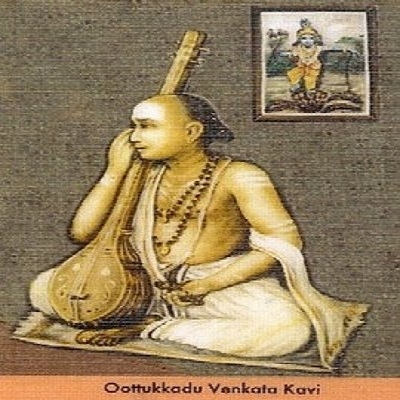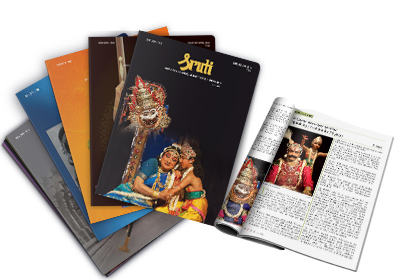
Most lovers of Carnatic music and Bharatanatyam are familiar with the Todi raga song Taye Yasodha. But many of them may not know who the author of this immortal composition is. Still less would they be aware that this composer, Oothukadu Venkatasubbier (or Oothukadu Venkatakavi) lived before Tyagaraja, that he sang from the joy born out of the love of God and not for the song itself and that he, in the process, composed a very large number of songs. The songs of this vaggeyakara which are still known are said to be but a fraction of his total creation. Even these could be lost to posterity but for the efforts taken some years ago by the Harikatha exponent Needamangalam Krishnamurthi Bhagavatar and the efforts now on hand to collect and publish the songs of this composer. The latter is one of the main tasks being undertaken by the recently constituted Oothukadu Venkatakavi Academy in Madras. Not much is known about the life of Venkatasubbier. What is known contains elements of legend. But through all this, the composer stands out as a great devotee of Lord Krishna and as a simple and modest man who shunned publicity and 'recognition'. Oothukadu is a small town on the northern bank of the river Vettar, a branch of the river Kaveri, about 13 km south of Kumbakonam in Tamil Nadu. There is, in this town, an ancient shrine of Lord Krishna with an idol which is venerated as 'swayambhu' (selfmanifested). The temple's utsavamurti—the idol which is taken out on procession—is that of Krishna dancing on the head of the serpent Kaliya, holding the latter's tail in his left hand. This four-foot idol is a sculptural masterpiece: the dancing Krishna has his right leg lifted. And the left foot, while appearing to rest on the hood of the serpent, does not quite touch the hood—a thread can be passed between the foot and the snake's hood. Thus the entire weight of the idol is on the tail of the serpent, which is, as it were, casually held by the playful Krishna in his left hand. It is this dancing Krishna (Nartana Krishna) who was the special object of devotion for Venkatasubbier and who inspired the devotee to pour out his boundless bhakti in song after song. Venkatasubbier is believed to have been bom at the beginning of the 18 th century. (According to one version, he lived from 1700 to 1765).
He was born in Mannargudi, a town in the Tanjavur district of Tamil Nadu, to Ramachandra Vathoolar and Kamalanayani Animal. After a brief period, during which he lived in nearby Needamangalam, he moved to Oothukadu. His elder brother, Kattu Krishna Iyer, was a musician in the court of the king of Tanjavur. Venkatasubbier learnt some music early in his life from Pooranur Natesa Bhagavatar also known as Raja Bhagavatar. When he had learnt all he could from this guru, Venkatasubbier was unable to find anyone to give him further lessons in music. His own brother Kattu Krishna Iyer would not teach him.
Legend has it that his mother thereupon advised the dejected Venkatasubbier to appeal to Lord Krishna and to deem Krishna himself as his guru. From then on, Venkatasubbier sang only in the presence of the Lord and is said to have experienced visual and aural manifestations of Krishna. The inspired bhakta went on to give expression to his devotion in a large number of songs, in Tamil and Sanskrit. While many of the songs are on Lord Krishna, Venkatasubbier in fact included in his musical tributes all the most important deities of the Hindu pantheon. Among the compositions are Navavama kriti-s on Goddess Kamakshi. Muthuswamy Dikshitar is the only other composer to author navavama kriti-s.
Venkatasubbier spent his entire life in devotion to god and remained a bachelor. He had no disciple. It is not clear how long he lived in this world, different versions putting it at between 60 and 90 years. Venkatasubbier was a loner and preferred to sing in seclusion, for his own joy and for expressing his love for god. It is due to fortuitous circumstances that atleast a part of his creations have come down to posterity.
Only a "fifth or sixth of what is known to be available of Venkatasubbier's compositions has come to light so far. And of these only a few are in vogue. The first song composed by him is said to be Idu oru tiramamo, in Begada. This is a well-known piece. The songs include a set of 11 described as navavama kriti-s. Since his time, only Muthuswamy Dikshitar has composed navavama songs. While Dikshitar's pieces are mostly in ghana or weighty raga-s, Venkatasubbier has used mostly rakti raga-s, like Arabhi, Balahamsa, Hindolam and Nadanamakriya.
One of the navavama compositions is set to a very rare tala, Sankeema Matya, which has 20 aksharakala-s of nine laghu-s followed by a drutam and again nine laghu-s. Venkatasubbier's list includes seven ragamalika-s (all in Tamil) and three tillana-s (in Surati, Sindhubhairavi and Puraneermai, respectively).
Not only in the navavarna-s. but generally too, Venkatasubbier has shown preference to rakti raga-s and to simple raga-s derived from folk melodies. He has used some rare raga-s too, like Kannada Maruva, Deepara and the already mentioned Puraneermai, a raga found in Tamil writings on music.
His brother’s descendants, Needamangalam Krishnamurti Bhagavadar, Oothukadu brothers, Kalyanasundaram, Rajagopalan and Mutthukrishnan continue to preserve and promote his musical traditions.


